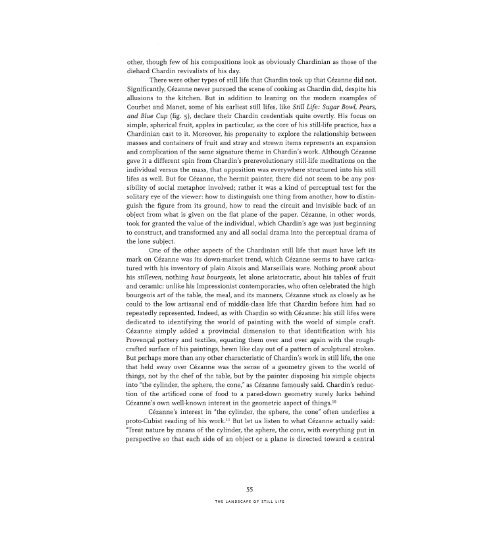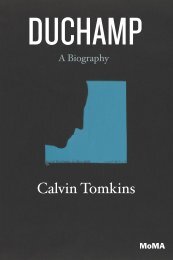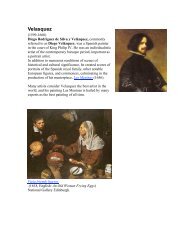Still Life in Watercolors
qbj8dgc
qbj8dgc
- No tags were found...
Create successful ePaper yourself
Turn your PDF publications into a flip-book with our unique Google optimized e-Paper software.
other, though few of his compositions look as obviously Chard<strong>in</strong>ian as those of the<br />
diehard Chard<strong>in</strong> revivalists of his day.<br />
There were other types of still life that Chard<strong>in</strong> took up that Cézanne did not.<br />
Significantly, Cézanne never pursued the scene of cook<strong>in</strong>g as Chard<strong>in</strong> did, despite his<br />
allusions to the kitchen. But <strong>in</strong> addition to lean<strong>in</strong>g on the modern examples of<br />
Courbet and Manet, some of his earliest still lifes, like <strong>Still</strong> <strong>Life</strong>: Sugar Bowl, Pears,<br />
and Blue Cup (fig. 5), declare their Chard<strong>in</strong> credentials quite overtly. His focus on<br />
simple, spherical fruit, apples <strong>in</strong> particular, as the core of his still-life practice, has a<br />
Chard<strong>in</strong>ian cast to it. Moreover, his propensity to explore the relationship between<br />
masses and conta<strong>in</strong>ers of fruit and stray and strewn items represents an expansion<br />
and complication of the same signature theme <strong>in</strong> Chard<strong>in</strong>'s work. Although Cézanne<br />
gave it a different sp<strong>in</strong> from Chard<strong>in</strong>'s prerevolutionary still-life meditations on the<br />
<strong>in</strong>dividual versus the mass, that opposition was everywhere structured <strong>in</strong>to his still<br />
lifes as well. But for Cézanne, the hermit pa<strong>in</strong>ter, there did not seem to be any possibility<br />
of social metaphor <strong>in</strong>volved; rather it was a k<strong>in</strong>d of perceptual test for the<br />
solitary eye of the viewer: how to dist<strong>in</strong>guish one th<strong>in</strong>g from another, how to dist<strong>in</strong>guish<br />
the figure from its ground, how to read the circuit and <strong>in</strong>visible back of an<br />
object from what is given on the flat plane of the paper. Cézanne, <strong>in</strong> other words,<br />
took for granted the value of the <strong>in</strong>dividual, which Chard<strong>in</strong>'s age was just beg<strong>in</strong>n<strong>in</strong>g<br />
to construct, and transformed any and all social drama <strong>in</strong>to the perceptual drama of<br />
the lone subject.<br />
One of the other aspects of the Chard<strong>in</strong>ian still life that must have left its<br />
mark on Cézanne was its down-market trend, which Cézanne seems to have caricatured<br />
with his <strong>in</strong>ventory of pla<strong>in</strong> Aixois and Marseillais ware. Noth<strong>in</strong>g pronk about<br />
his stilleven, noth<strong>in</strong>g haut bourgeois, let alone aristocratic, about his tables of fruit<br />
and ceramic: unlike his Impressionist contemporaries, who often celebrated the high<br />
bourgeois art of the table, the meal, and its manners, Cézanne stuck as closely as he<br />
could to the low artisanal end of middle-class life that Chard<strong>in</strong> before him had so<br />
repeatedly represented. Indeed, as with Chard<strong>in</strong> so with Cézanne: his still lifes were<br />
dedicated to identify<strong>in</strong>g the world of pa<strong>in</strong>t<strong>in</strong>g with the world of simple craft.<br />
Cézanne simply added a prov<strong>in</strong>cial dimension to that identification with his<br />
Provençal pottery and textiles, equat<strong>in</strong>g them over and over aga<strong>in</strong> with the roughcrafted<br />
surface of his pa<strong>in</strong>t<strong>in</strong>gs, hewn like clay out of a pattern of sculptural strokes.<br />
But perhaps more than any other characteristic of Chard<strong>in</strong>'s work <strong>in</strong> still life, the one<br />
that held sway over Cézanne was the sense of a geometry given to the world of<br />
th<strong>in</strong>gs, not by the chef of the table, but by the pa<strong>in</strong>ter dispos<strong>in</strong>g his simple objects<br />
<strong>in</strong>to "the cyl<strong>in</strong>der, the sphere, the cone," as Cézanne famously said. Chard<strong>in</strong>'s reduction<br />
of the artificed cone of food to a pared-down geometry surely lurks beh<strong>in</strong>d<br />
Cezanne's own well-known <strong>in</strong>terest <strong>in</strong> the geometric aspect of th<strong>in</strong>gs. 10<br />
Cezanne's <strong>in</strong>terest <strong>in</strong> "the cyl<strong>in</strong>der, the sphere, the cone" often underlies a<br />
proto-Cubist read<strong>in</strong>g of his work. 11 But let us listen to what Cézanne actually said:<br />
"Treat nature by means of the cyl<strong>in</strong>der, the sphere, the cone, with everyth<strong>in</strong>g put <strong>in</strong><br />
perspective so that each side of an object or a plane is directed toward a central<br />
55<br />
THE LANDSCAPE OF STILL LIFE




